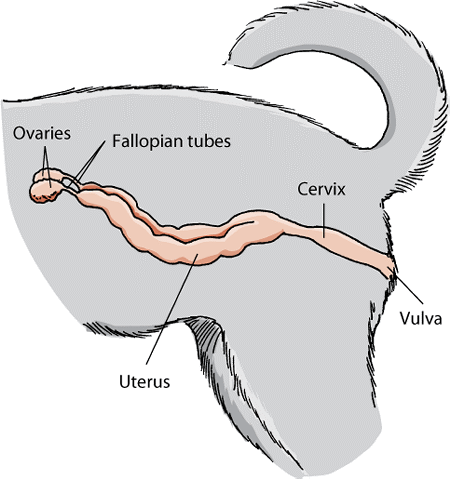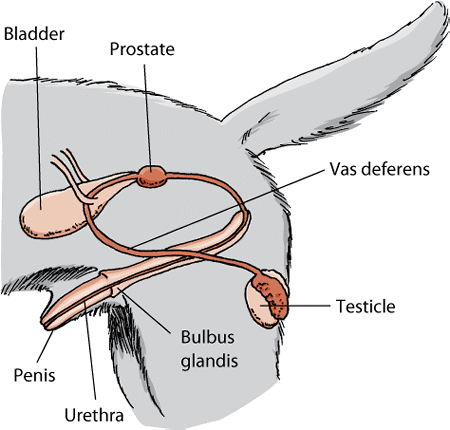The Gonads and Genital Tract of Dogs
- Reproductive Disorders of Dogs
- Introduction to Reproductive Disorders of Dogs
- The Gonads and Genital Tract of Dogs
- Management of Reproduction in Dogs
- Infertility in Dogs
- Reproductive Disorders of Male Dogs
- Reproductive Disorders of Female Dogs
- Mammary (Breast) Tumors in Dogs
- Brucellosis in Dogs
- Transmissible Venereal Tumor in Dogs
Also see professional content regarding the gonads and genital tract.
Both sexes have a pair of sexual organs or gonads (ovaries or testes), the main function of which is to produce eggs or sperm, respectively.
The Ovaries
Ovaries are female gonads that produce eggs and female sex hormones, including estrogen and progesterone. Estrogen is necessary for the development of eggs, and progesterone prepares the uterus for pregnancy. Once puberty is reached and the dog starts its heat or estrous cycle, the size and form of the ovaries change. Within the ovary, a group of special cells called a follicle surround each egg. The estrous cycle begins when follicle stimulating hormone stimulates follicles to grow, leading to maturation of eggs and production of the hormone estrogen. Estrogen causes the brain to release luteinizing hormone, which stimulates the release of eggs from the ovary (a process called ovulation). After ovulation, progesterone, produced by the ovary, prepares the uterus for pregnancy and the mammary glands for milk production.
The Testes
Testes are male gonads that produce sperm and male sex hormones. Sperm maturation is stimulated by the production and release of follicle stimulating hormone and testosterone. Testosterone is required for proper function of the accessory sexual glands, male sex characteristics (for example, larger size), and sexual behavior. For sperm production, the testes must descend into the scrotum (a pouch of skin outside the abdomen), because regular body temperature is too high for sperm to develop normally. The function of the testicles can be assessed by an evaluation of semen samples and hormonal tests. In addition, testicle examination and measurement can help evaluate fertility and may reveal reproductive diseases.
The Female Genital Tract
The female genital tract includes the vulva, vagina, cervix, uterus, oviducts, and ovaries, as well as the mammary glands found on the chest and abdomen. The oviducts are small tubes that connect the ovaries to the uterus. The end of the uterus is called the cervix. It separates the uterus from the vagina and provides a barrier against infection. The vagina (a muscular tube that extends from the cervix to the outside) is connected to the vulva (skin surrounding the opening of the vagina). The vulva is the external opening of the female genitals. An oviduct is connected to each ovary. After ovulation, eggs are transported to the uterus via the oviducts. Secretion of fluid in the oviducts provides a proper environment for survival of the mature egg, fertilization, and the first few critical days of embryonic life. Proper functioning of the uterus and cervix are also required for the establishment and maintenance of pregnancy.
Infections contracted at mating can be a cause of female infertility because they interfere with the proper function of the uterus. Infertility in females can be diagnosed through various means, including x-rays, ultrasonography, physical examination, and blood tests. The vagina and vulva serve as the copulatory organs and as the last part of the birth canal. They also provide a route for infections, particularly when the vulva cannot function properly due to trauma or relaxation.
The Male Genital Tract
In males, the genital tract provides a pathway for sperm cells and semen. The epididymis connects the testicle to the ductus deferens, which carries ejaculated sperm to the urethra. Sperm mature and are stored in the epididymis. The accessory sex glands, such as the prostate, create the fluid portion of semen. Cancer and inflammation of the genital tract can be diagnosed by physical examination or ultrasonography. Other diseases or abnormal functioning can be diagnosed by testing semen samples.
For More Information
Also see professional content regarding the gonads and genital tract.
Resources In This Article
- Reproductive Disorders of Dogs
- Introduction to Reproductive Disorders of Dogs
- The Gonads and Genital Tract of Dogs
- Management of Reproduction in Dogs
- Infertility in Dogs
- Reproductive Disorders of Male Dogs
- Reproductive Disorders of Female Dogs
- Mammary (Breast) Tumors in Dogs
- Brucellosis in Dogs
- Transmissible Venereal Tumor in Dogs







